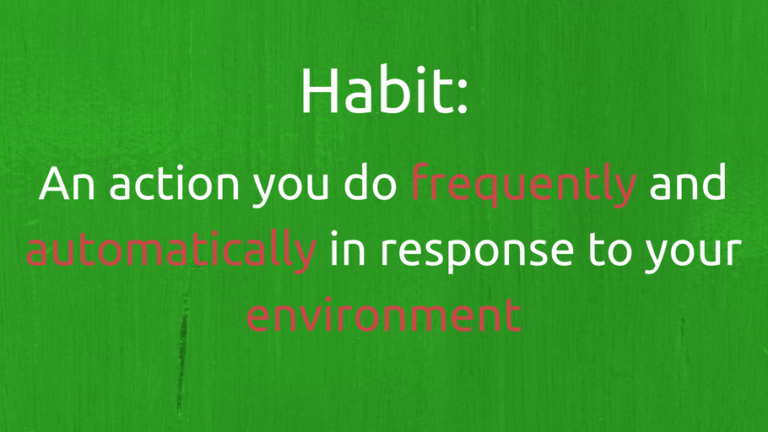How does social media so readily capture our hearts and minds? The answer lies in how effectively it forms new habits. These papers show the role of habits in spreading misinformation, persistent posting, and effective quitting
Ceylan, G., Anderson, I. A., & Wood, W. (2023). Sharing of misinformation is habitual, not just lazy or biased. Proceedings of the National Academy of Sciences, 120(4), e2216614120 {access paper}
Anderson, I. A., & Wood, W. (2023). Social motivations’ limited influence on habitual behavior: Tests from social media engagement. Motivation Science, 9(2), 107–119 {access paper}

Why don’t people understand their habits better? Even habitual coffee drinkers underestimate the effects of habit and attribute that next cup to a desire for a pick-me-up. This paper reveals what we know about our own habits.
Mazar, A., & Wood, W. (2022). Illusory feelings, elusive habits: People overlook habits in explanations of behavior. Psychological Science, 33(4), 563-578. {access paper}

What is the psychology behind habits? A common view is that habits form as we repeat rewarded responses in a stable context. Once formed, habits are activated automatically by context cues. But recently, some researchers have tried to repurpose the habit construct as a kind of goal pursuit. These papers show why this is wrong and why it’s important.
Wood, W., Mazar, A., & Neal, D. T. (2022). Habits and goals in human behavior: Separate but interacting systems. Perspectives on Psychological Science,17(2),590-605.{access paper}
Wood, W. (2024). Habits, goals, and effective behavior change. Current Directions in Psychological Science. {access paper}

Electronic versions are provided as a professional courtesy. Copyrights continue to reside with the copyright holders, as noted in each paper.
-
- Ratay, C., Webb, T. L., Wood, W., & Mohnen. A. (2024). Does a holiday break disrupt pro-environmental behaviors? Using field data to test the durability of pro-environmental behaviors and the moderating effect of habit. Resources, Conservation & Recycling, 203.{access paper}
- Mazar, A., & Wood, W. (2022). Illusory feelings, elusive habits: Explanations of behavior overlook habits. Psychological Science, 33(4), 563-578.{access paper}
- Mazar, A., Tomaino, G., Carmen, Z., & Wood, W. (2021). Habits to save our habitat: Using the psychology of habits to promote sustainability. Behavioral Science & Policy. {access paper}
- Wood, W., Mazar, A., & Neal, D. (2021). Habits and goals in human behavior: Separate but interacting systems. Perspectives on Psychological Science. {access paper}
- Anderson, I., & Wood, W. (2021). Habits and the electronic herd: The psychology behind social media’s successes and failures. Consumer Psychology Review, 4(1), 83-99. {access paper}
- Carden, L., & Wood, W. (2018). Habit formation and change. Current Opinion in Behavioral Sciences, 20, 117-122. {access paper}
- Itzchakov, G., Uziel, L., & Wood, W. (2018). When attitudes and habits don’t correspond: Self-control depletion increases persuasion but not behavior. Journal of Experimental Social Psychology, 75, 1-10. {access paper}
- Wood, W. (2017). Habit in personality and social psychology. Personality and Social Psychology Review, 21, 1-17. {access paper}
- Labrecque, J. S., Wood, W., Neal, D. T., & Harrington, N. (2017). Habit slips: When consumers unintentionally resist new products. Journal of the Academy of Marketing Science, 45, 119-133. {access paper}
- Wood, W., & Neal, D. T. (2016). Healthy through habit: Interventions for initiating and maintaining health behavior change. Behavioral Science & Policy, 2, 71-83. {access paper}
- Lin, P. Y., Wood, W., & Monterosso, J. (2016). Healthy eating habits protect against temptations. Appetite, 103, 432-440. {access paper}
- Wood, W., & Ruenger, D. (2016). Psychology of habits. Annual Review of Psychology, 37, 289-314. {access paper}
- Wood, W., Labrecque, J., Lin, P-Y., & Ruenger, D. (2014). Habits in dual process models. In J. Sherman, B. Gawronski, & Y. Trope (Eds.), Dual process theories of the social mind (pp. 371-385). New York: Guilford {access paper}
- Neal, D. T., Wood, W., & Drolet, A. (2013). How do people adhere to goals when willpower is low? The profits (and pitfalls) of strong habits. Journal of Personality and Social Psychology, 104, 959–975. {access paper}
- Neal, D. T., Wood, W., Labrecque, J., & Lally, P. (2012). How do habits guide behavior? Perceived and actual triggers of habits in daily life. Journal of Experimental Social Psychology, 48, 492-498. {access paper}
- Aldrich, J., Montgomery, J., & Wood, W. (2011). Turnout as a habit. Political Behavior, 33, 535–563.{access paper}
- Neal, D. T., Wood, W., Wu, M., & Kurlander, D. (2011). The pull of the past: When do habits persist despite conflict with motives? Personality and Social Psychology Bulletin, 37, 1428–1437. {access paper}
- Quinn, J. M., Pascoe, A. T., Wood, W., & Neal, D. T. (2010). Can’t control yourself? Monitor those bad habits. Personality and Social Psychology Bulletin, 36, 499-511. {access paper}
- Wood, W., & Neal, D. T. (2009). The habitual consumer. Journal of Consumer Psychology, 19, 579-592. {access paper}
- ********** *winner of the best paper of the year, Journal of Consumer Psychology
- Rothman, A. J., Sheeran, P., & Wood, W. (2009). Reflective and automatic processes in the initiation and maintenance of food choices. Annals of Behavioral Medicine, 28 (Suppl), 4-17. {access paper}
- Neal, D. T., & Wood, W. (2009). Automaticity in situ and in the lab: The nature of habit in daily life. In E. Morsella, J. A. Bargh, P. Gollwitzer (Eds.), Oxford handbook of human action (pp. 442-457). Mechanisms of human action. New York: Oxford. {access paper}
- Wood, W., & Neal, D. T. (2007). A new look at habits and the interface between habits and goals. Psychological Review, 114, 843–863. {access paper}
- Ji Song, M., & Wood, W. (2007). Purchase and consumption habits: Not necessarily what you intend. Journal of Consumer Psychology, 17, 261–276. {access paper}
- Verplanken, B., & Wood, W. (2006). Interventions to break and create consumer habits. Journal of Public Policy and Marketing, 25, 90-103. {access paper}
- Neal, D. T., Wood, W., & Quinn, J. M. (2006). Habits: A repeat performance. Current Directions in Psychological Science, 15, 198-202. {access paper}
- Wood, W., Tam, L., & Guerrero Witt, M. (2005). Changing circumstances, disrupting habits. Journal of Personality and Social Psychology, 88, 918-933. {access paper}
- Wood, W., Quinn, J. M., & Kashy, D. (2002). Habits in everyday life: Thought, emotion, and action. Journal of Personality and Social Psychology, 83, 1281-1297. {access paper}
- Ouellette, J., & Wood, W. (1998). Habit and intention in everyday life: The multiple processes by which past behavior predicts future behavior. Psychological Bulletin, 124, 54-74. {access paper}
-
- Wood, W., & Eagly, A. H. 2015). Two traditions of research on gender identity. Sex Roles, 73, 461-473. {access paper}
- Wood, W. (2016). Reply to Gangestad’s commentary. Emotion Review, 8, 90-94. {access paper}
- Wood, W., & Carden, L. (2014). Elusiveness of menstrual cycle effects on mate preference: Comment on Gildersleeve, Haselton, and Fales (2014). Psychological Bulletin, 140, 1265-1271. {access paper}
- Wood, W., Kressel, L., Joshi, P. D., & Louie, B. (2104). Meta-analysis of menstrual cycle effects on women’s mate preferences. Emotion Review, 6, 229-249. {access paper}
- Eagly, A. H., & Wood, W. (2013). The nature-nurture debates: 25 years of challenges in the psychology of gender. Perspectives on Psychological Science, 8, 340-357. [access paper]
- Wood, W., & Eagly, A. H. (2012). Biosocial construction of sex differences and similarities in behavior. In M. P. Zanna & J. M. Olson (Eds.), Advances in experimental social psychology. San Diego, CA: Academic Press. {access paper}
- Eagly, A. H., & Wood, W. (2011). Feminism and the evolution of sex differences and similarities. Sex Roles, 64(9-10), 758-767. [access paper]
- Richman, L. S., VanDellen, M., & Wood, W. (2011). How women cope: Being a numerical minority in a male-dominated profession. Journal of Social Issues, 67, 492-509. {access paper}
- Wood, W., & Eagly, A. H. (2010). Gender. In S. T. Fiske, D. T. Gilbert, & G. Lindzey (Eds.), Handbook of social psychology ( Vol. 1, 5th ed., pp. 629-667). New York: Wiley {access paper}
- Witt, M. G., & Wood, W. (2010). Self-regulation of gendered behavior in everyday life. Sex Roles, 62, 635-646. {access paper}
- Wood, W., & Eagly, A. H. (2009). Gender identity. In M. Leary & R. Hoyle (Eds.), Handbook of individual differences in social behavior (pp. 109-128).New York: Guilford. {access paper}
- Eagly, A. H., Wood, W., & Johannnesen-Schmidt, M. C. (2004). The social role theory of sex differences and similarities: Implications for partner preference. In A. H. Eagly, A. Beall, & R. J. Sternberg (Eds.), Psychology of gender (2nd ed, pp. 269-295). New York: Guilford. {access paper}
- Eagly, A. H., Wood, W., & Diekman, A. (2000). Social role theory of sex differences and similarities: A current appraisal. In T. Eckes & H. M. Trautner (Eds.), The developmental social psychology of gender (pp. 123-174). {access paper}
- Boldry, J., Wood, W., & Kashy, D. (2001). Sex stereotypes and the evaluation of men and women in military training. Journal of Social Issues, 57, 689-706. Mahwah, NJ: Erlbaum. {access paper}
- Wood, W., & Eagly, A. H. (2007). Social structural origins of sex differences in human mating. In S. Gangestad & J. A. Simpson (Eds.), The evolution of mind: Fundamental questions and controversies (383-390). New York: Guilford.{access paper}
- Eagly, A. H., & Wood, W. (2005). Universal sex differences across patriarchal cultures ≠ evolved psychological dispositions. Behavioral and Brain Sciences, 28, 281-283.
- Wood, W., & Eagly, A. H. (2002). A cross-cultural analysis of the behavior of women and men: Implications for the origin of sex differences. Psychological Bulletin, 128, 699-727. {access paper}
- Wood, W., & Eagly, A. H. (2000). A call to recognize the breadth of evolutionary perspectives: Sociocultural theories and evolutionary psychology. Psychological Inquiry, 11, 52-55. {access paper}
- Eagly, A. H., & Wood, W. (1999). The origins of sex differences in human behavior: Evolved dispositions versus social roles. American Psychologist, 54, 408-423. {access paper}
- Wood, W., Christensen, P. N., Hebl, M. R., & Rothgerber, H. (1997). Conformity to sex-typed norms, affect, and the self-concept. Journal of Personality and Social Psychology, 73, 523-535. {access paper}
- Shackelford, S., Wood, W., & Worchel, S. (1996). Behavioral styles and the influence of women in mixed-sex groups. Social Psychology Quarterly, 59, 284-293. {access paper}
- Grossman, M., & Wood, W. (1993). Sex differences in emotional intensity: A social role interpretation. Journal of Personality and Social Psychology, 65, 1010-1022. {access paper}
- Wood, W., Rhodes, N., & Whelan, M. (1989). Sex differences in positive well-being: A consideration of emotional style and marital status. Psychological Bulletin, 106, 249-264. {access paper}
-
- Biek, M., Wood, W., & Chaiken, S. (1996). Working knowledge, cognitive processing, and attitude: On the determinants of bias. Personality and Social Psychology Bulletin, 22, 547-556. {access paper}
- Wood, W., Rhodes, N. D., & Biek, M. (1995). Working knowledge and attitude strength: An information-processing analysis. In R. Petty & J. Krosnick (Eds.), Attitude strength: Antecedents and consequences (pp. 283-313). Hillsdale, NJ: Erlbaum.{access paper}
- Wood, W., & Kallgren, C. A. III. (1988). Communicator attributes and persuasion: Recipients’ access to attitude-relevant information. Personality and Social Psychology Bulletin, 14, 172-182. {access paper}
- Kallgren, C. A., III, & Wood, W. (1986). Access to attitude-relevant information in memory as a determinant of attitude-behavior consistency. Journal of Experimental Social Psychology, 22, 328-338. {access paper}
- Wood, W., Kallgren, C., & Preisler, R. M. (1985). Access to attitude-relevant information in memory as a determinant of persuasion: The role of message attributes. Journal of Experimental Social Psychology, 21, 73-85. {access paper}
- Wood, W. (1982). The retrieval of attitude-relevant information from memory: Effects on susceptibility to persuasion and on intrinsic motivation. Journal of Personality and Social Psychology, 42, 798-810. {access paper}
-
- Quinn, J. M., & Wood, W. (2004). Forewarnings of influence appeals: Inducing resistance and acceptance. In E. S. Knowles and J. A. Linn (Eds.), Resistance and persuasion (pp. 193-214). Mahwah, NJ: Erlbaum. {access paper}
- Wood, W., & Quinn, J. M. (2003). Forewarned and forearmed? Two meta-analytic syntheses of forewarnings of influence appeals. Psychological Bulletin, 129, 119-138. {access paper}
-
- Wood, W., & Eagly, A. H. (2009). Testing theories and conducting research from meta-analytic syntheses. In H. Cooper, L. Hedges, & J. Valentine (Eds.), Handbook of research synthesis (2nd ed, pp. 455-472). New York: Russell Sage.[access paper]
- Wood, W., & Christensen, P. N. (2003). Quantitative research synthesis across studies, paradigms, and time. In C. Sansone, C. C. Morf, & A. T. Panter (Eds.), Handbook of methods in social psychology (pp. 335-356). Thousand Oaks, CA: Sage. {access paper}
-
- Wood, W., & Hayes, T. (2012). Social influence on consumer decisions: Motives, modes and consequences. Journal of Consumer Psychology, 22, 324-328. {access paper}
- Hall, D. T., Matz, D., & Wood, W. (2010). Why don’t we practice what we preach? A meta-analytic review of religious racism. Personality and Social Psychology Review, 14, 126-139. {access paper}
- Matz, D., & Wood, W. (2005). Cognitive dissonance in groups: The consequences of disagreement. Journal of Personality and Social Psychology, 88, 22-37. {access paper}
- Prislin, R., & Wood, W. (2005). Social influence: The role of social consensus in attitudes and attitude change. In D. Albaraccin, B. T. Johnson, & M. P. Zanna (Eds.), Handbook of attitudes and attitude change (pp. 671-706). Hillsdale, NJ: Erlbaum. {access paper}
- Christensen, P. N., Rothgerber, H., Wood, W., & Matz, D. C. (2004). Social norms and identity relevance: A motivational model of normative impact. Personality and Social Psychology Bulletin, 30, 1295-1309. {access paper}
- Orina, M., Wood, W., & Simpson, J. A. (2002). Strategies of influence in close relationships. Journal of Experimental Social Psychology, 38, 459-472. {access paper}
- Wood, W. (2000). Attitude change: Persuasion and social influence. Annual Review of Psychology, 51, 539-570. {access paper}
- Wood, W. (1999). Motives and modes of processing in the social influence of groups. In S. Chaiken & Y. Trope (Eds.), Dual process theories in social psychology (pp. 547-570). New York: Guilford Press. {access paper}
- Pool, G. J., Wood, W., & Leck, K. (1998). The self-esteem motive in social influence: Agreement with valued majorities and disagreement with derogated minorities. Journal of Personality and Social Psychology, 75, 967-975. {access paper}
- Wood, W., Pool, G., Leck, K., & Purvis, D. (1996). Self-definition, defensive processing, and influence: The normative impact of majority and minority groups. Journal of Personality and Social Psychology, 71, 1181-1193. {access paper}
- Wood, W., Lundgren, S., Ouellette, J., Busceme, S., & Blackstone, T. (1994). Minority influence: A meta-analytic review of social influence processes. Psychological Bulletin, 115, 323-345. {access paper}